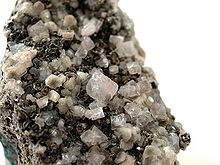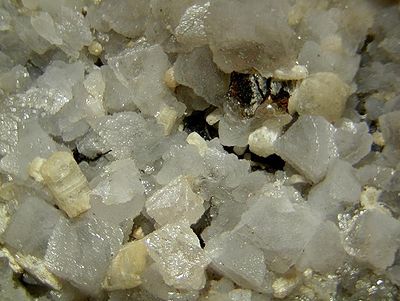Goyazite
| Goyazite | |
|---|---|
| Milky white goyacite crystals from Rapid Creek, Yukon , Canada (field of view: 20 mm) | |
| General and classification | |
| chemical formula | SrAl 3 [(OH) 6 | PO 3 OH | PO 4 ] |
|
Mineral class (and possibly department) |
Phosphates, arsenates, vanadates |
|
System no. to Strunz and to Dana |
8th BL.10 ( 8th edition : VII / B.36) 07/22/03/03 |
| Similar minerals | Arsenogoyacite |
| Crystallographic Data | |
| Crystal system | trigonal |
| Crystal class ; symbol | ditrigonal-scalenohedral 3 2 / m |
| Room group (no.) | R 3 m (No. 166) |
| Lattice parameters | a = 7.02 Å ; c = 16.50 Å |
| Formula units | Z = 3 |
| Physical Properties | |
| Mohs hardness | 4.5 to 5 |
| Density (g / cm 3 ) | measured: 3.26; calculated: 3.29 |
| Cleavage | completely after {0001} |
| Break ; Tenacity | uneven |
| colour | colorless, white, pink, purple, lemon yellow, brown, gray, orange |
| Line color | White |
| transparency | transparent |
| shine | Glass gloss to resin gloss, mother-of-pearl gloss on split surfaces |
| Crystal optics | |
| Refractive indices |
n ω = 1.620 n ε = 1.630 |
| Birefringence | δ = 0.010 |
| Optical character | uniaxial positive |
| Pleochroism | weak in thick grains: ω = light pink; ε = yellowish, greenish |
Goyazite , also known as bowmanite , hamlinite or lusungite , is a mineral from the mineral class of phosphates , arsenates and vanadates , which can sometimes be found in abundance in various locations, but is generally not very widespread.
Goyazite crystallizes in the trigonal crystal system with the chemical composition SrAl 3 [(OH) 6 | PO 3 OH | PO 4 ] and develops mostly transparent crystals about two centimeters in diameter with a tabular, rhombohedral or pseudocubic habit and a glass - to resin - like shine on undamaged crystal surfaces . Gap surfaces, on the other hand, have a pearly luster . Goyazite also occurs in the form of granular to massive mineral aggregates .
Special properties

Pure goyazite is colorless or white due to lattice construction defects or in the case of multi-crystalline formation. However, it can also take on a gray, pink to purple, lemon-yellow, orange or brown color when it is mixed in. However, the line color is always white.
Etymology and history
Goyazite was first discovered near Diamantina in the Brazilian state of Minas Gerais . The mineral was analyzed and described in 1884 by Augustin Alexis Damour , who named it after the neighboring province of Goiás (formerly Goyaz ), known for its diamond-rich river sands .
classification
In the meanwhile outdated, but still in use 8th edition of the mineral classification according to Strunz , goyazite belonged to the mineral class of "phosphates, arsenates and vanadates" and there to the department of "anhydrous phosphates with foreign anions ", where together with arsenocrandallite , arsenoflorencite- ( La) , Arsenoflorencit- (Ce) , Arsenoflorencit- (Nd) , Arsenogorceixit , Arsenogoyazit , Arsenowaylandit , Benauit , Crandallit , Dussertit , Eylettersit , Florencit- (La) , Florencit- (Ce) , Florencit- (Nd) , Gorceixit , Graulichit - (Ce) , Kintoreit , Philipsbornit , Plumbogummit , Segnitit , Springcreekit , Waylandite , zaïrite formed a distinct group.
The 9th edition of Strunz's mineral systematics , which has been in effect since 2001 and is used by the International Mineralogical Association (IMA), also assigns goyazite to the class of “phosphates, arsenates and vanadates” and there to the department of “phosphates etc. with additional anions ; without H 2 O “. However, this section is further subdivided according to the size of the cations involved and the ratio of the other anions to the phosphate, arsenate or vanadate complex RO 4 , so that the mineral can be classified in the sub-section “With medium-sized and large cations; (OH etc.): RO 4 = 3: 1 “can be found where it is found together with arsenocrandallite, arsenoflorencite (Ce), arsenogorceixite, arsenogoyazite, benauite, crandallite, dussertite, eylettersite, florencite (Ce), florencite ( La), florencite (Nd), gorceixite, grayichite (Ce), pattersonite, kintoreit, philipsbornite, plumbogummite, segnitite, springcreekite, waylandite and zaïrit as well as the minerals arsenoflorencite- (La), arsenoflorencite- ( Nd) and arsenowaylandite form the unnamed group 8.BL.10 .
The systematics of minerals according to Dana , which is mainly used in the English-speaking world , assigns Goyazite to the class of "phosphates, arsenates and vanadates", but there in the category of "water-containing phosphates etc., with hydroxyl or halogen". Here it is together with Crandallit, Gorceixit, Lusungit, Plumbogummit, Kintoreit, Benauit and Springcreekit in the "Crandallit group" with the system no. July 42, 2003 within the subsection of " Water-containing phosphates etc., with hydroxyl or halogen with (AB) 5 (XO 4 ) 3 Z q × x (H 2 O) ".
Education and Locations

Goyazite forms in hydrothermally argillitized weathering zones ( argillic alteration ) granitic pegmatites , i.e. in this zone various minerals were converted into clay minerals . The mineral is also found in the kaolinitized clay soils of former volcanic tuffs and carbonatites . Accompanying minerals include various apatites , barite , diamond , herderite , kaolinite, monazite , pyrite , quartz and sphalerite .
In total, Goyazit has so far (as of 2011) been found at around 120 sites. In addition to its type locality Diamatina, the mineral occurred in Brazil in several places in the Jequitinhonha Valley and near Barreiro in Minas Gerais, in the carbonatites of Goyaz and in the communities of Viseu ( Pará ) and Frei Martinho ( Paraíba ).
In Germany, Goyazit was found in the Clara mine in Baden-Württemberg; at Rotenfels , at Leupoldsdorf and at Großer Waldstein in the Fichtelgebirge and at Hagendorf - Waidhaus in Upper Palatinate in Bavaria as well as at Greifenstein and at Sadisdorf in Thuringia.
In Austria, the mineral has so far been found on the Katschberg between Carinthia and Salzburg as well as in several places in the Fischbacher Alps and on the Galgenberg near Leoben in Styria , and in Switzerland it has so far only occurred in the cantons of Graubünden and Valais .
Other locations are Australia , Bolivia , Burundi , China , France , Italy , Japan , Canada , Kazakhstan , Kenya , Madagascar , Malawi , Namibia , Poland , Romania , Russia , Slovakia , Spain , South Africa , the Czech Republic , Tunisia , Ukraine , Uzbekistan and the United States of America (USA).
Crystal structure
Goyazite crystallizes trigonal in the space group R 3 m (space group no. 166) with the lattice parameters a = 7.02 Å and c = 16.50 Å as well as 3 formula units per unit cell .
use
Except as a mineral sample, goyazite has no economic significance.
See also
Individual evidence
- ↑ a b c d e Hugo Strunz , Ernest H. Nickel: Strunz Mineralogical Tables . 9th edition. E. Schweizerbart'sche Verlagbuchhandlung (Nägele and Obermiller), Stuttgart 2001, ISBN 3-510-65188-X , p. 462 .
- ↑ Webmineral - Goyazite (English)
- ↑ a b Handbook of Mineralogy - Goyazite (English, PDF 63.9 kB)
- ↑ a b Goyazite at mindat.org (engl.)
- ↑ A. Damour (1884): Note sur un nouveau phosphate d'alumine et de chaux, des terrains diamantifères , in: BULLETIN DE LA SOCIETE MINERALOGIOUE DE FRANCE , Paris, 7, pp. 204–205 (French, PDF 147.8 kB)
- ↑ Definition of argillic alteration
Web links
- Mineral Atlas: Goyazit (Wiki)
